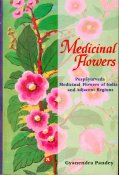
Book
Reviews
Book 26
Medicinal Flowers – Medicinal Flowers of India and Adjacent Regions

by
Pandey G. pub. Sri Satguru Publications, Delhi 1992 ISBN 81-7030-351-7.
Copyright © Tony
Burfield June 2004
I
must admit to being rather drawn to the concept surrounding the title of this
un-illustrated book, which, including the indexes, covers some 209 pages.
Further, by now having a modest collection of Indian books on the natural flora,
the essential oils, the spices and the vegetable drugs of this vast continent, I
am struck by how many times the same piece of information turns up (often
un-referenced!) across all of these books.
However,
within the bounds of the references available to these hard-working authors (who
I mentally picture sifting through tomes like The
Wealth of India in
order to compile scraps of information), one cannot be too critical. The
achievement of Medicinal Flowers
itself is to make an interesting collection of such pieces of relevant
information all in one source book.
The
book starts with a Prelusive Sketch, which describes amongst other things, the
thematic object of the work, and how it is set out (: alphabetically by genus).
We are informed there are some five hundred species entries from 212 genera
within the text. Chapter One, entitled Plants Enumeration, is the major part of
the book covering 159 pages. Most entries, which you can calculate for
yourselves must average three per page, are just a few lines long. Nevertheless,
to the aromatic plant researcher, or the ethnobotanist, or just anyone
interested in flowers, perfumes or aromatherapy, there is some interesting
material here. Dipping in here and there is fascinating. For example Aglaia
odorata, the
Chinese produced oil of which I have been recently studying, I now know, is
grown in S. India and the flowers may find use in treating leprosy (and thanks
to a US colleague, I now separately know, that the fragrance of the flower was
chosen by the distinguished chemist Roman Kaiser to be diffused during the
playing of Scheherazade by Nikolay Rimsky-Korsakov at an annual concert festival
in Lucerne Switzerland! (Chem. &
Eng. News July 14,
2003 p60). The many applications of the Neem tree (Azadirachta
indica) are not let
down by the Neem tree flowers, which have several uses also, including their
utilisation in the form of a paste for killing head lice, and for eruptive skin
complaints.
Lotus
flowers (Nelumbo nucifera)
also apparently have a number of uses – for example saline extracts of
flowers, stem and leaves said to possess anti-bacterial properties. Reference in
the book to previous production of Lotus perfume from the flowers is interesting
since some of us are still looking for authentic (i.e. 100% derived from the
named botanic source) lotus essential oil! Viola species get a relatively large
entry with interesting reports of Viola
pilosa use in
ethnic preparations such as Joshanda, a household decoction against colds.
Chapter
two is a source texts supplement, covering just over thirty pages
(Classical Compedia, Materia Medica and other Treatises) the scholarship
of which I cannot unfortunately appreciate because it is in script language,
which in my utter ignorance, I take to be Sanskrit (?). Again, it is to my
disadvantage that I cannot make out much of Chapter three which deals with
Classical terminology indicating floral features. Finally an appendix entitled
Task approach: Medicinal flowers – perspectives and dimensions indicates 10
(huge) tasks, including surveys of the vast knowledge of the body of Indian
literature, which might lead, in conjunction with a symbiosis of modern
biological and medicinal science, to a Flowers or Arboreal type of medicine.
I really
like the idea of this book, and I was sufficiently impressed to have bought
several copies to sell at cost (about £6), since with such a good start in the
subject of Medicinal Flowers,
it would be such a pity to leave it there. Perhaps someone will expand the
subject by writing a companion volume….!